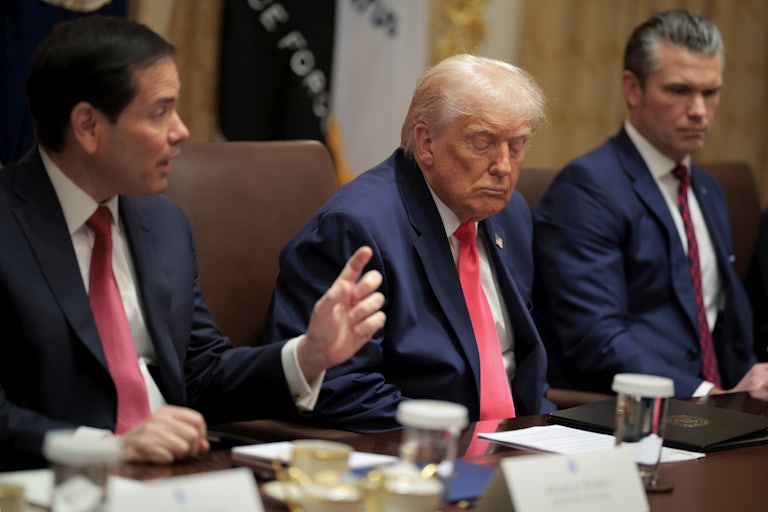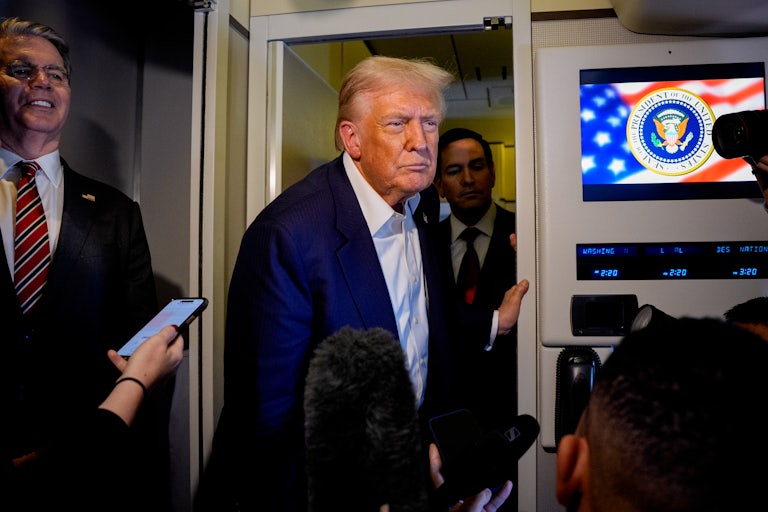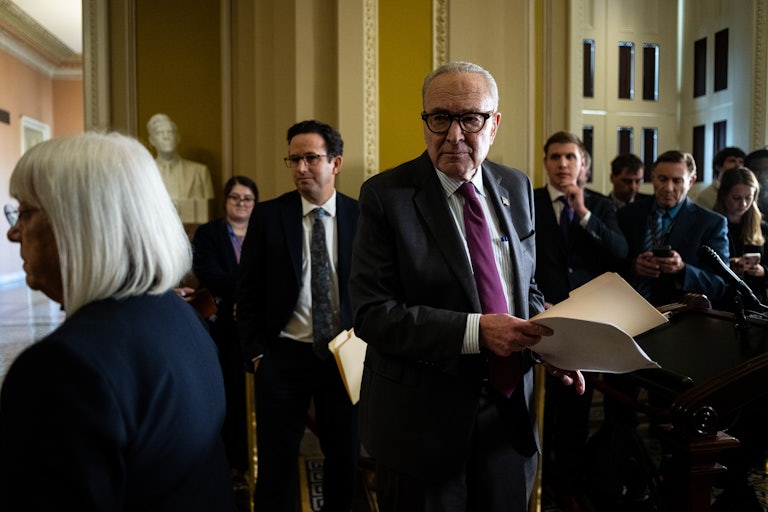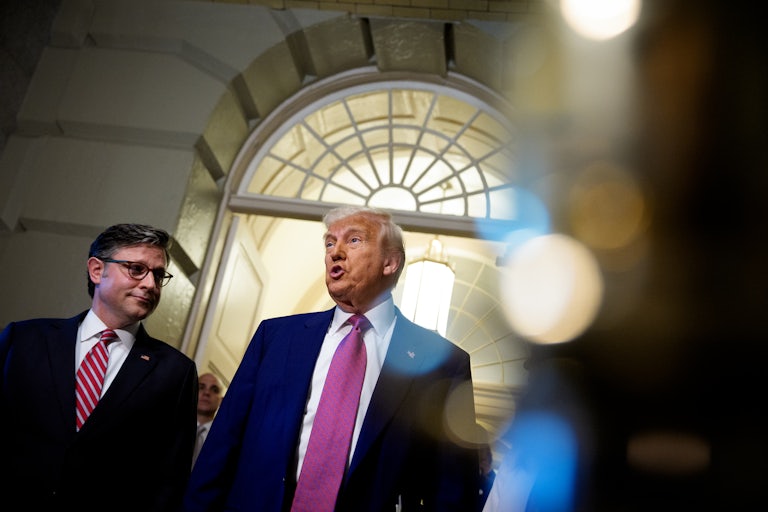The Nine Worst Trump Scandals of 2025
Trump’s second term has been so lurid in its corruption that it was genuinely hard to narrow this list down.

As longtime readers may recall, I’ve always wondered if Donald Trump truly intended to win the 2016 election. Howard Stern asked him why he wanted to take the world’s hardest job when he “only had about 10 good years left before he ‘starts to drool’ on himself”—which now seems pretty prophetic. Weeks into his first term, Trump was already giving melancholy interviews about how he missed his old life. It really seemed that his first presidential run was a goof that went sideways, to the detriment of all of us.
But as for his effort to reclaim the Oval Office? I’ve never wondered why he wanted back in. The second time out, he ran on a combination of desperation to avoid jail, a desire for revenge, and unmitigated avarice. He pretty much ran on a platform of looting the country and punishing his perceived enemies. With the gift of immunity from the Supreme Court, he spent the first year of his second term taking bigger swings at double-dealing, committing more brazen acts of corruption. There are far too many examples to do an exhaustive, let alone authoritative, list of crimes. But these are the ones that stuck with me particularly in a year of misrule.
The UAE crypto bribe: It’s not every day one of TNR’s staff writers gets to compare a scandal to Teapot Dome, but that’s how Tim Noah described the shady dealings that went down between Trump and his shadowy backers from the United Arab Emirates, who—in what’s been characterized as the largest cryptocurrency transaction in history—made a $2 billion stablecoin purchase in World Liberty Financial, which is essentially the president’s personal crypto slush fund. With quid like that, you knew that a sizable pro quo was to come. Sure enough, Trump permitted the UAE to import a larger quantity of U.S.-produced AI computer chips than it was allowed under the Biden administration. Simple enough scandal to understand, right? Well, as Noah later noted, the business press seems to not get it.
Plane and simple corruption: So, it’s kind of hard to do the whole “nothing to see here!” routine when the nothing is a luxury 747 that your Qatari friends want to off-load on the president. Trump tried to sell this gift as the new Air Force One, a generous gesture in return for all the money the United States has spent providing security for our nominal Gulf allies. The plane became the subject of a long-simmering dispute, as Democrats have attempted to block it from being used as Air Force One. Regardless, as Alex Shephard noted, the debasement in this arrangement exceeded the mere quid pro quo: “Trump wants to be treated as a king, and Qatar is playing ball.”
Death of USAID: Russell Vought, Elon Musk, and their wrecking crew of DOGE bros spent the first half of the year visiting destruction upon the civil service; the damage done is something we’ll all be feeling for a long time. But the most damnable part of their legacy may be the dismantling of foreign aid agencies like the United States Agency for International Development. A Boston University study found that the agency’s demise had “already caused the deaths of six hundred thousand people, two-thirds of them children.” “We are now witnessing what the historian Richard Rhodes termed ‘public man-made death,’” wrote the Harvard School of Public Health’s Atul Gawande.
Bombs over Latin America: It’s giving Wag the Dog, if you ask me. The administration, seemingly hot to bring back neoconservative military conquest, soft-launched its latest regime change war in Venezuela by making indiscriminate attacks on boats in the Caribbean and Pacific waters off of Central America. These attacks, all undertaken without a jot of congressional oversight and on the dubious premise that the boats were packed with fentanyl bound for the United States, were murderous on their own. But the news that the military was ordered to strike an already stricken boat in a “double tap” attack to kill any survivors has raised the specter of war crimes—and in a way that even many Republicans don’t seem ready to countenance.
Trump’s Binance buddy gets a pardon: Changpeng Zhao began this year the disgraced former CEO of Binance, the world’s largest cryptocurrency exchange, having done prison time for, as the Biden DOJ put it, “failing to maintain an effective anti-money laundering (AML) program,” violating the Bank Security Act, and allowing money to flow freely to a host of bad actors, including “terrorists, cybercriminals, and child abusers.” But Zhao, having forfeited the right to run Binance, wanted back in. So he used his connections to Trump’s family and inner circle to secure a pardon that would let him run the show again. In return, Zhao showered his attention on World Liberty Financial—using Binance’s leverage to enrich Trump’s private crypto fund. TNR’s Tim Noah was positively apoplectic about the shady arrangement.
Chips to China: Speaking of Tim Noah and apoplexy: It’s probably not great that one firm, Nvidia, has come to possess such godlike, market-moving power. Its outsize importance to the global economy had Noah fingering it as one of the major pillars to crumble, when he gamed out a potential Trump stock market crash back in October. Trump’s been doing what he can to boost Nvidia’s fortunes, however: This year, the president broke with long-standing national security tradition and announced that he was permitting the firm to sell its H200 chips to China. As The New York Times’ David Sanger noted, the deal—the fruits of “intense lobbying” from Nvidia CEO and White House gadfly Jensen Huang—raised a basic question: “If the chips that power the most advanced technology can be sold to the United States’ chief technological, military and financial competitor, where is the new line drawn?” That’s probably the least of Trump’s concerns, however: The deal also guaranteed that “25 percent of all the revenues from the sales would go to the United States,” in yet another case of this administration’s affection for fascist corporatism.
The continuing January 6 crime wave: Every once in a while, I like to check in with the people who were given presidential pardons by Trump for their crimes of sacking the U.S. Capitol and attempting to overturn the 2020 presidential election by force. Here’s one who killed a person in a drunk-driving incident. Here’s another. Here’s the guy who plotted to kill the FBI agents who investigated him for the Capitol riot. Here’s the alleged child molester who tried to buy his victim’s silence with fictitious “January 6 reparations” money. Here’s another alleged child sex predator who at least made no claims about pending reparations. Here’s a man arrested for allegedly threatening to kill Hakeem Jeffries. Here’s the guy who’s inexplicably not yet been arrested for stalking and threatening Jamie Raskin. What’s this? Another alleged child sex predator? This guy who was arrested for absconding with “industrial copper wire valued at tens of thousands of dollars” seems quaint by comparison. Anyway, there are scores of these repeat offenders, so I think we can all agree that these pardons were a spectacular idea.
ICE’s war on U.S. citizens: The administration has coupled its turning loose of January 6 criminals on our streets with the incessant plucking of law-abiding citizens off those same streets. An October report from ProPublica brought the gory details: “More than 170 cases this year where citizens were detained at raids and protests,” including 20 instances in which citizens “reported being held for over a day without being able to call their loved ones or a lawyer.” As I wrote around the same time, Trump shares (dis)credit with Supreme Court Justice Brett Kavanaugh. In his concurring opinion in Noem v. Vasquez Perdomo, Kavanaugh etched his name into infamy by contending, “If the person is a U.S. citizen or otherwise lawfully in the United States, that individual will be free to go after the brief encounter.” As ProPublica’s Nicole Foy wrote, this “is far from the reality many citizens have experienced”:
Americans have been dragged, tackled, beaten, tased and shot by immigration agents. They’ve had their necks kneeled on. They’ve been held outside in the rain while in their underwear. At least three citizens were pregnant when agents detained them. One of those women had already had the door of her home blown off while Department of Homeland Security Secretary Kristi Noem watched.
The ultimate symbol of Trumpian corruption: The fact of the matter is that the White House actually could use a ballroom. But what it’s getting, in the form of Trump’s teardown of the East Wing to make way for his planned monument to his bottomless ego, is something that ably sums up the despicable nature of this presidency and its cronies. As TNR’s Matt Ford wrote in a lengthy jeremiad on the topic, “The raw spectacle of Trump tearing a hole in the White House to hang out with his rich friends is already a potent symbol of his presidency.… At every level, the entire project may be the perfect summation of what his administration has been like for the country.” Perhaps the one good thing about the ballroom is that Democratic presidential contenders can compete with one another over who will tear it down best.
I could go on like this: And I probably should. But I would go on forever. There’s Signalgate, the firing of numerous inspectors general, and the extortion campaigns against businesses, universities, and Big Law firms. Robert F. Kennedy’s deadly anti-vaccine policies are a mass-casualty crime in the making. We’re building concentration camps and shipping people to gulags. We’re threatening Canada and Greenland. Trump’s tariffs are ruining Christmas. He stole $230 million for himself. And the only reason I haven’t mentioned l’affaire Jeffrey Epstein until now is that it’s been so ever-present in our lives that I don’t actually need to remind you about it.
But the biggest scandal of all is something Trump didn’t create. It’s this country’s piss-poor legacy of holding the powerful to account—a major factor in both Trump’s rise to power and the foundation of the era of elite impunity in which we are all mired. So whether your favorite Trump scandal made the cut here or not, keep its memory close, nurture your fury, and seek out the future leaders who will not shrink from the task of holding Trump and his enablers accountable for their howling criminality—who will push the envelope to bring retributive justice when their time in power comes.
This article first appeared in Power Mad, a weekly TNR newsletter authored by deputy editor Jason Linkins. Sign up here. Power Mad will return in 2026.









